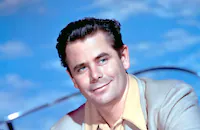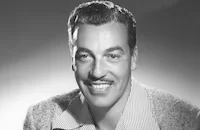The Americano
Cast & Crew
William Castle
Glenn Ford
Frank Lovejoy
Cesar Romero
Ursula Thiess
Abbe Lane
Film Details
Technical Specs

Synopsis
In Clearwater, Texas, cattleman Sam Dent borrows money from the bank so that he can ship his three prize Brahma bulls to Brazil, where a buyer has promised him $25,000. With his last dollars, Sam then purchases a ticket for himself and accompanies the animals to a port in Brazil. When the buyer, Antoni Barbossa, fails to show, Sam makes inquiries at a bar but is met with frightened silence. One man, Manoel Silva, however, leads Sam to Barbossa's slain body and agrees to guide Sam to Barbossa's ranch for a fee. The jovial but cryptic Manoel then procures a truck in which to transport the bulls. Fifty miles from Barbossa's ranch, Manoel and Sam abandon the truck and start to herd the bulls on horses "borrowed" by Manoel. Sam and Manoel guide the animals through a jungle onto the Matto Grosso plateau, where grazing land is lush but the cattle overbred. After Manoel leads the bulls safely across a piranha-infested river, they are surprised by several stampeding cowboys. Sam knocks down one of the riders, who turns out to be Marianna Figuerido, Barbossa's unfriendly neighbor. When Marianna learns that Sam plans to sell the bulls to Barbossa's "captain," Bento Hermanny, she reacts with anger, declaring that Hermanny has been trying to steal her land for years. Moments later, Hermanny appears and shoots a puma that is about to attack Sam. While escorting Sam to his ranch, Hermanny asks about Manoel, who has disappeared, and reveals that Manoel is the notorious bandit El Gato and most likely the man who murdered Barbossa. Hermanny also admits that Marianna resents him because his ranch is much more successful than her modest one. Later, at his ranch house, Hermanny, who describes himself as Barbossa's partner, offers Sam a piece of the ranch in exchange for his cattle expertise. Sam politely declines, admitting that he and his brother have long dreamed of buying their own land in Texas. After Hermanny goes out to hunt for Manoel, who has been spotted in the area, Sam finds Manoel sitting in the dark. Manoel does not deny he is El Gato, but warns Sam not to accept Hermanny's job. The next morning, Sam leaves for home with Eduardo, one of Hermanny's men, carrying $25,000 in cash. While camping in the jungle, several men ambush Sam, knocking him out, and when he revives, he finds his money stolen and Eduardo murdered. Sam rides back to Hermanny and collapses, and Hermanny accuses Manoel of the crime. Later, Cristino, Hermanny's foreman, and several other men attack Marianna's foreman, Tuba Macedo, claiming that Tuba is hiding Manoel. Although Tuba denies any knowledge, Cristino hangs him in front of Sam, who is outraged. After Hermanny tries to defend Cristino's actions, he and Sam are surprised by Manoel and his men. Manoel takes Sam to Marianna's ranch, where Teresa, Hermanny's seductive housekeeper, confesses that she is Manoel's sweetheart and spy. Teresa tells Sam that she overheard Hermanny ordering Cristino to rob him and also knows that Hermanny had Barbossa killed. Though still unsure about Hermanny, Sam admits his attraction for Marianna and spends a romantic evening with her. The next morning, the police show up at Marianna's, intent on arresting Sam for Tuba's murder. Marianna stalls the police and races to Hermanny's to see Sam, but when Sam insists that he is not taking sides, she leaves in disgust. That night, Hermanny instructs Cristino and his men to set fires to the homes of "roceiros," or nesters, who have occupied the area. Shocked by Hermanny's brutal tactics, Sam confronts him, and he admits he was behind the jungle ambush. Hermanny then reveals that because Marianna put up her land as a guarantee that Sam would appear in court during Tuba's murder investigation, he has ordered Cristino to force Sam onto a Texas-bound boat to assure that he fails to show. As Cristino and his men are leading Sam through the jungle, however, Sam manages to escape and joins up with Manoel at Marianna's. Later, Sam sneaks back to Hermanny's and jumps Cristino in the bunkhouse, holding him at gunpoint. Cristino promises to implicate Hermanny to the authorities, but when Sam takes him to the police captain, Gonzales, Cristino turns on Sam and accuses him of the crime. Gonzales is about to arrest Sam when Manoel and his cohorts appear and help Sam escape with Cristino. Sam then drags Cristino to the river and, by threatening to immerse him in the piranha-infested water, again gets him to agree to implicate Hermanny. After Cristino confesses to Gonzales, they all ride to Hermanny's. There, Manoel fights with Cristino in the stables, killing him with a pitchfork, and Sam then is compelled to shoot the cowardly Hermanny after he shoots Gonzales. Exhausted but victorious, Sam walks off, finally free to return to Texas.

Director

William Castle
Cast

Glenn Ford

Frank Lovejoy

Cesar Romero
Ursula Thiess
Abbe Lane
Rodolfo Hoyos Jr.
Salvador Báguez

Tom Powers

Dan White
Frank Marlowe
George Navarro
Nyra Monsour
Crew
C. Bakaleinikoff
Xavier Cugat
Xavier Cugat
Edward Donahue
Benny Dyonisio
Oscar Ferreira Filho
Harry Marker
Frank Mcwhorter
Jack Okey
George Rosner
Julius Sadoske
Nate Slott
Tom Smith
William Snyder
Bert Spurlin
Robert Stillman
Clifford Stine
John Sturtevant
Guy Trosper
Roy Webb
Sam Wiesenthal
Michael Woulfe

Film Details
Technical Specs

Quotes
Trivia
Notes
Contemporary news items add the following information about the production: The Americano began shooting in late July 1953 at the Companhia Cinematografica Vera Cruz Studios in São Paulo, Brazil. Initially, the film was to be shot in Tru-Stereo 3-D, under the direction of Budd Boetticher and starring Glenn Ford, Arthur Kennedy, Cesar Romero and Sara Montiel. Ben Colman was the first announced cinematographer and Lyle Willey, the soundman. By the time principal photography began, however, Clifford Stine had replaced Colman, and the film was not in 3-D. It is not known whether Willey actually worked on the production. In addition to São Paulo, several weeks of filming took place on the Matto Grosso in Brazil. Because of unseasonably bad weather, as well as problems relating to the film's Brazilian financing, the company was forced to return to Los Angeles in late September 1953, after shooting only one-third of the script.
Although Daily Variety announced that the picture would resume filming in October 1953 at the Motion Picture Center in Los Angeles, shooting did not begin again until mid-June 1954, with a different director and photographer. Boetticher was replaced by William Castle and Stine by William Snyder. Ursula Thiess replaced Montiel in the female lead and Frank Lovejoy replaced Kennedy. In addition, RKO Radio Pictures and Robert Stillman Productions took over from Moulin Productions as the film's production companies, and RKO took over distribution from United Artists. Stillman was the producer throughout filming. It is not known how much of the footage shot in Brazil was used in the final film, which was released in standard format.
Hollywood Reporter news items from 1954 add Susan Hamilton, Leon Bovaro and Joe Dominguez to the cast, but their appearance in the final film has not been confirmed. Production charts note that the 1953 footage was shot in Eastman Color. Reviews list the film's aspect ratio as either 1.75:1 or 1.85:1.

Miscellaneous Notes
Released in United States Winter January 1955
Released in United States Winter January 1955











